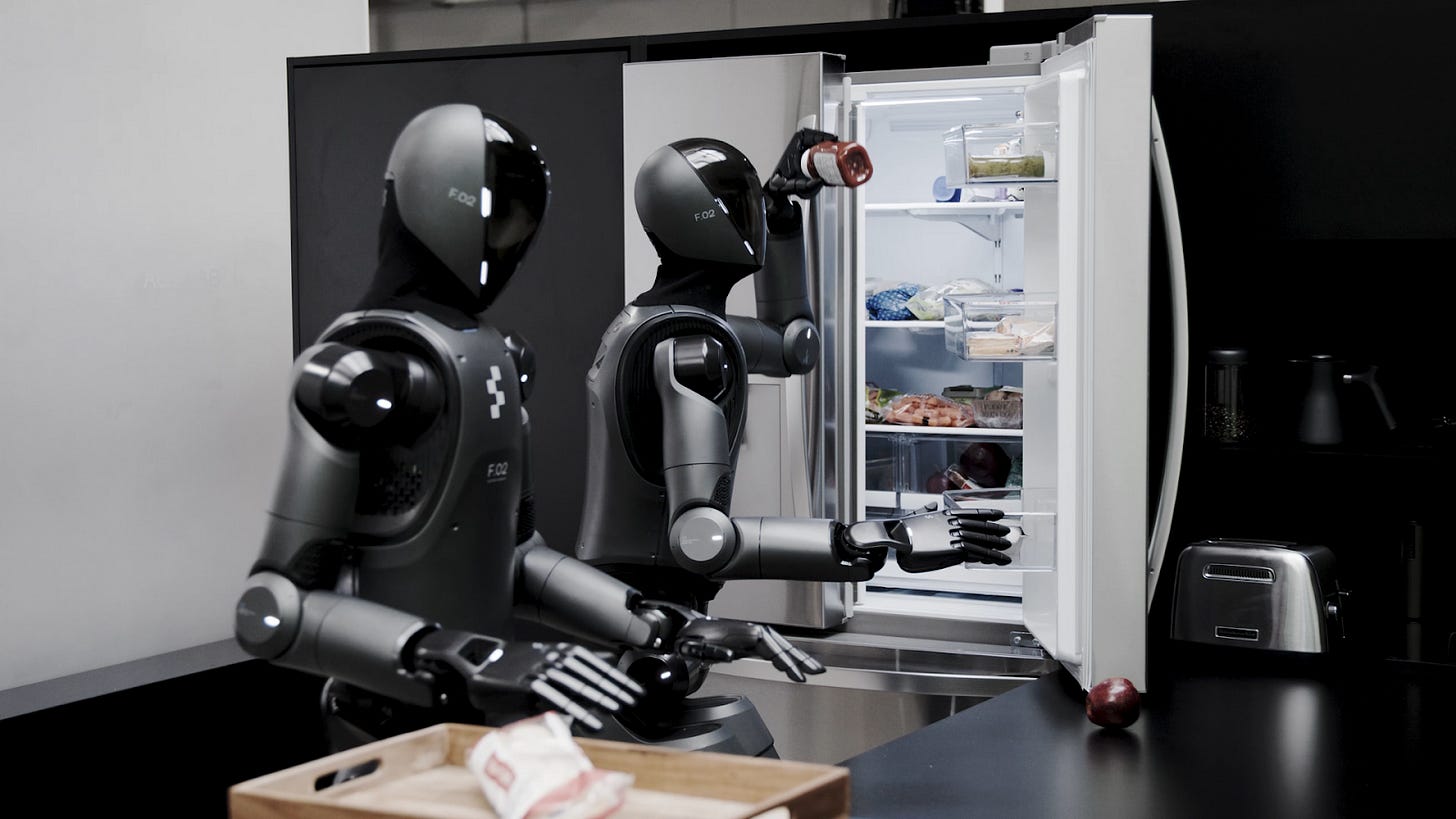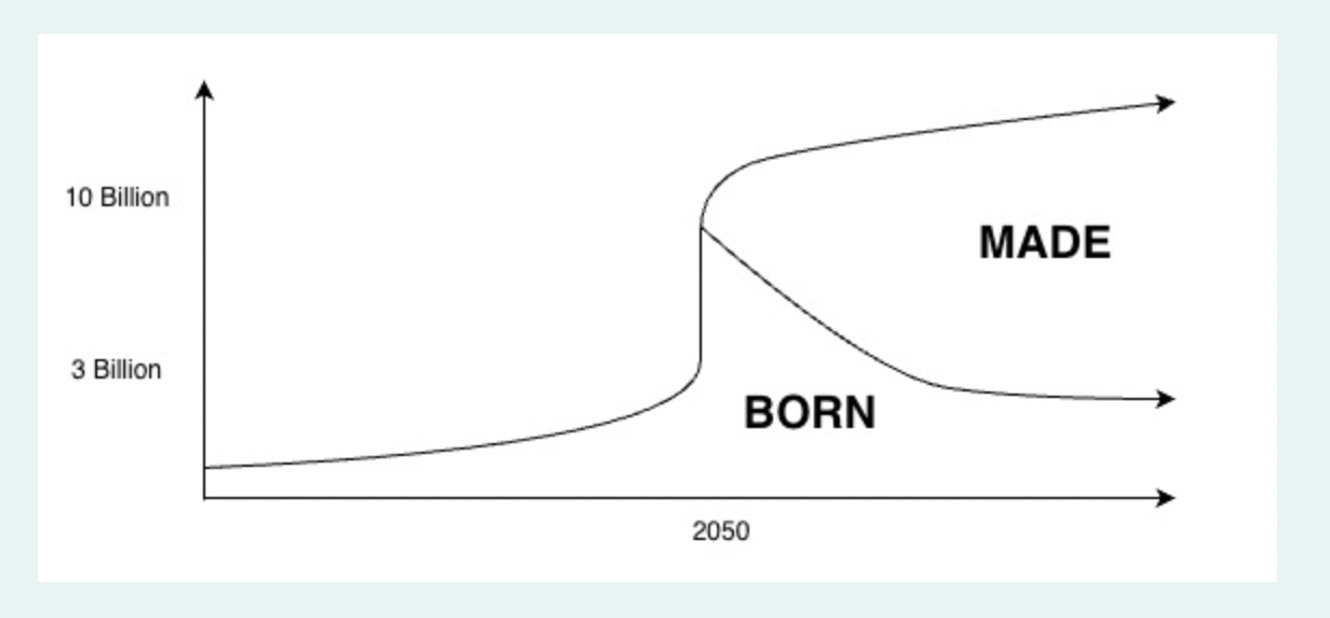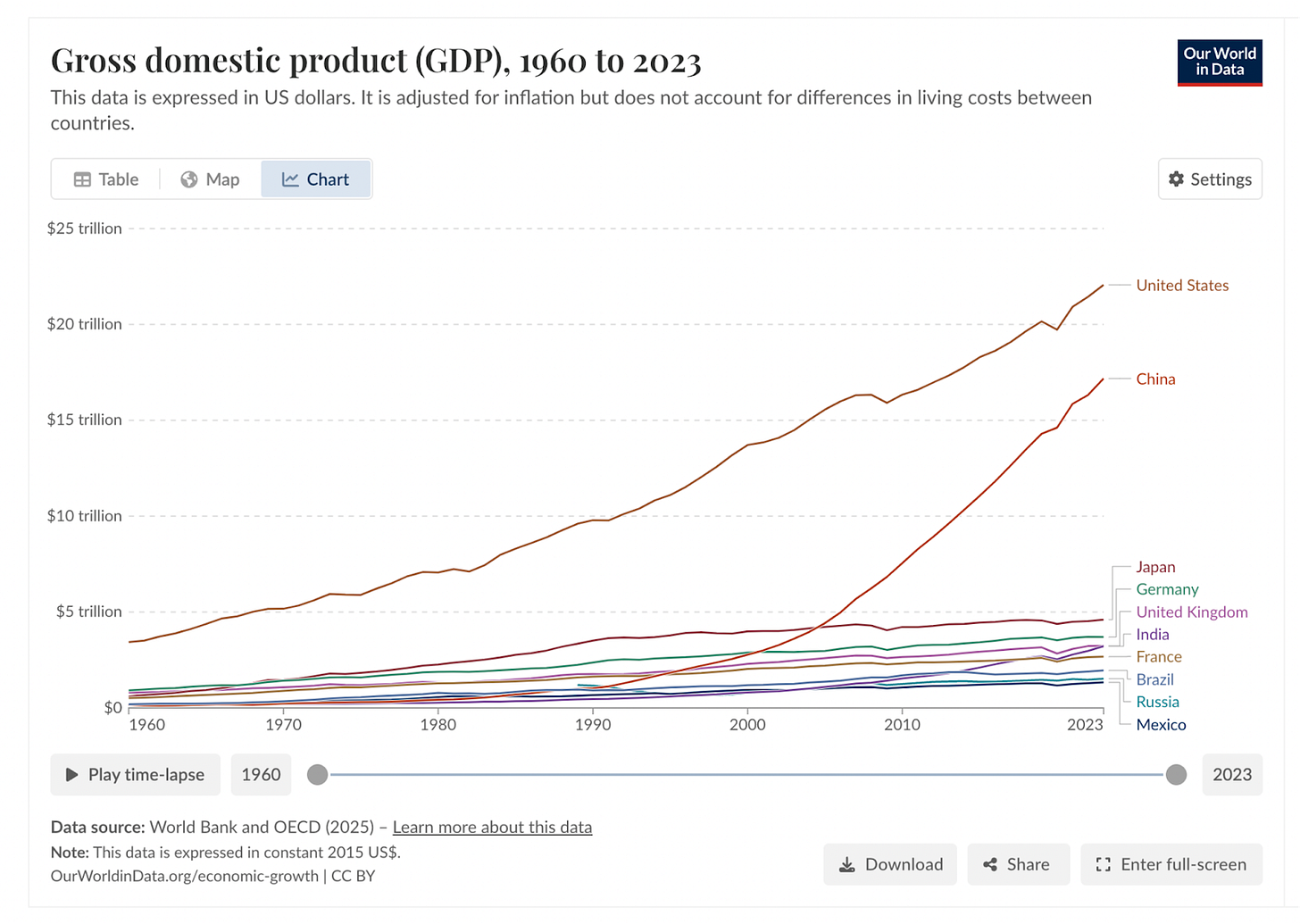Post-Human Economics
An essay from The Exponentialist
Welcome to this special update from New World Same Humans, a newsletter on trends, technology, and society by David Mattin.
If you’re reading this and haven’t yet subscribed, join 30,000+ curious souls on a journey to build a better future 🚀🔮
It’s been too quiet around here recently.
Which is, of course, my doing. I’ve been working on a couple of big projects across the summer; time has been at a premium. The real point is: both projects have major implications for the future of this community. I can’t wait to share more on all that in the coming weeks.
In the meantime, though, I’ve still been writing a whole lot. As most of you know, along with Raoul Pal I run The Exponentialist, a community focused on emerging technologies and their economic, social, and human implications.
In this special update, then, I’d like to share a recent essay from The Exponentialist. One that allows you a glimpse of the kind of work I do there. And that articulates a set of ideas that are at the heart of my current thinking on our shared future.
The essay introduces a theme I’ve been developing for a while now. It is about post-human economics and a great coming civilisational quest to create more intelligence per unit energy.
This is an attempt, really, to envision a world in which AI and robots have created conditions of radical knowledge and material abundance. When this happens, everything we know about the economy as it exists today starts to break down. I want to try to make sense of that. And of what comes next.
In this essay I make a few mentions of last month’s essay. That piece argued that in a post-human economy, GDP is no longer a coherent measure of economic flourishing. But all that is recapped in this essay; everything you need to understand this piece is contained within it.
These kinds of essays go out to Exponentialists every month, along with a tech-focused investment portfolio, monthly community chats with me and Raoul, and regular guest interviews.
You can go here to learn more about The Exponentialist. But that’s enough preamble. Let’s get into it.
Post-Human Economics
What am I talking about when I use the phrase post-human economics?
The idea is tied to another, one that sits at the heart of my thinking on the Exponential Age. That idea is the coming economic singularity. It’s really this idea that I’m trying to extend — trying to fathom — when I talk about all this.
So the next question becomes: what do we mean by the economic singularity? In physics, a singularity is a point in spacetime where all the usual rules of physical reality break down.
The economic singularity thesis says that now — and via the convergence of a set of transformational technologies — we’re moving towards a transition that will see all the old rules of the economy break down. Via that transformation, the categories and very language we’ve always used to describe the economy will fall into incoherence.
Increasingly, this idea is the focus of my thinking. My research is converging around a set of related questions. What is the path to this singularity? What does the transition phase look like? Is it possible to peak beyond the event horizon, and understand the nature of post-singularity economic conditions?
Developing the idea of a post-human economics, then, is really about forging a new way to model all this. It’s about building a new language via which to approach the economic singularity.
In last month’s essay, I played with this idea. The transition into the singularity, I said, can be understood as a transition from an economy built on human inputs and conditions of scarcity — that means material, cognitive, and labour scarcity — to an economy built on automated inputs and conditions of radical abundance. And under those conditions, GDP no longer makes sense as a measure of economic flourishing.
In this essay, I attempt to push that idea to its logical conclusion. I do that by asking: if GDP is not a valid measure of economic flourishing inside a post-human economy, then what is? What should we measure?
My answer? Eventually, the most coherent measure of flourishing will be around how efficiently our civilization converts energy into intelligence. That is, it will be intelligence output per unit energy. In the post-human economy, everything lies downstream of better and more abundant intelligence. And under those conditions, the economy becomes an endless, relentless quest to maximise that metric.
When we understand the path to that world — a world in which intelligence output per unit energy is the best measure of flourishing — something amazing happens. We’re empowered not only to understand the transition from a human to a post-human economy, but to glimpse beyond the event horizon of the singularity, to the outlines of the post-human economy itself.
Just as it sounds, I’m attempting with all this to push my thinking to the very edges; to model the shape of the radically new world that is coming.
Figuring all this out means trying to piece together a seven-dimensional puzzle. One that none of us understands. I’m thinking aloud, step-by-step, and trying to make sense of it all. So treat all this as just one further step in a long journey, which is always subject to revision. The work of making sense of what’s happening now — of the emerging Exponential Age — is only just beginning.
Let’s get into it.
*
The Handoff
Before we get into the argument on intelligence output per unit energy, we need to revisit a prior question. What are the practical forces at work pushing us towards a posthuman economy?
Remember, we currently inhabit a human-centred economy. That means one built around human needs. One built on human inputs. And one enacted around conditions of scarcity; material scarcity, scarcity of human labour, and cognitive scarcity, too.
Those conditions are now being overturned. But how? I went deep into this in my last essay. And really, everything I’ve written about the Exponential Age can be deployed as an answer to that question. The answer, in a word, is technology. Technology is overturning those conditions.
But at the heart of the story are robots, especially humanoid robots. And AI, especially AGI, or superintelligence. They are the central path to a post-human economy.
When it comes to humanoids, advancement has been rapid over the last couple of years. Look at what’s happened in just the last few weeks.
The US humanoid startup Figure released HELIX, an AI that blends a sophisticated LLM and reasoning model with advanced machine vision. The result is a robot that can understand natural language, reason about its physical environment, and then take appropriate action. This means it can perform everyday, unstructured tasks via ordinary spoken instructions.
As Figure showed in their demonstration video, tell their 02 robot to ‘tidy the kitchen’ and it will now understand that celery goes in the fridge and canned fruit goes in the cupboard, even if it has never seen these objects before. And it can act on that understanding.
Other big players have just released similar models, too. DeepMind’s Gemini Robots and Nvidia’s GR00T N1 both allow humanoids to understand, reason, and act.
Right now, most of the humanoids on trial inside workplaces, such as Amazon fulfilment centres and BMW factories, are performing the same structured task over and over again. But HELIX and these other models are a key step towards humanoids that are able to work independently in everyday environments, taking a loose set of instructions such as ‘keep this place tidy’ or ‘sort these packages’ and acting on them in a coherent way. There’s still work to be done, but we’re getting closer to a ChatGPT moment for humanoids.
Meanwhile, as I wrote about at the start of the year, AGI feels ever-more imminent.
OpenAI’s o3 remains the frontier model for now. A reminder: look at its performance on the GPQA Diamond benchmark, a set of super-hard science and maths questions. It’s so good that it outperforms human PhDs who are answering questions in their specific scientific domain and who are allowed to use Google to help.
That’s why I call this The Last Chart. It’s the final chart we get to make as Earth’s apex intelligence. After this, we hand the baton to the machines:
Okay, there’s a little hyperbole at work in that statement. But not much.
Put this all together, and what is happening? The iconic technologist Kevin Kelly — co-founder of Wired magazine and a Silicon Valley legend — wrote a blog post recently that sums it all up so well.
That post was called The Handoff, and it taps into another core idea in Raoul’s work: demographics are destiny.
In the developed world, said Kelly, we’re about to hit a historic moment. The human population is about to peak and then start to decline — the first time that’s happened inside modernity. Meanwhile, billions of AI agents and tens of millions of humanoids are about to come online. They are the new worker population. When we think demographically, we can no longer think only about the entities that are born — the humans. We need to count the entities that are made, too — the AIs and robots.
What’s happening now, said Kelly, is a historic transition. It’s an economic handoff from we humans to the AI and robots we are creating.
If we accept this vision, the question becomes: what does this handoff do? What is the nature of this shift? The answers are far reaching: This shift will rewrite the underlying logic of the economy, transitioning it from an economy built on human inputs and conditions of scarcity, to one built on automated inputs and conditions of radical abundance. We move, in other words, towards a post-human economy.
I went deep on this process in last month’s essay.
First, AGI and agents will eliminate scarcity across many knowledge work domains. Across many services and knowledge-based industries — coding, law, marketing, consulting, finance and more — production of outputs will be substantially or completely automated. We’ll see the rise of instant, hyper-personalised, zero-cost production.
Eventually, this phenomenon will move beyond services and into physical products, too. Abundant energy will converge with humanoid robots and next-generation manufacturing techniques such as 3D printing to push the cost of much physical production down to something negligible.
In the next section, I want to zero in on this transition. What are its implications? And what is the nature of the new economic reality it is leading us towards?
Another question can act as a kind of proxy for these deeper, more complex ones. In the new world that is coming, what will we measure?
*
What Do We Measure?
We know what we measure now. Inside the human-centred economy we’ve built, GDP is the principal measure of flourishing.
But as we saw in the previous essay, as we transition towards a post-human economy, GDP starts to become incoherent as a measure of anything meaningful.
Automated outputs across much of the knowledge and services economy will push prices to zero. Eventually this will move to some physical products, too. So we’ll see huge economic welfare gains — lots of great new stuff! — that is not captured by GDP.
At the same time, we’ll see AIs transacting with AIs in lots of ways. This could produce skyrocketing GDP growth rates — 10%, 50%, 100% per year — via activity that is entirely divorced from any impact on we humans or our wellbeing.
Once we get there, what does GDP even mean? And if we don’t measure GDP, then what do we measure? If we understand the answer to that question, I think we understand so much more.
Remember, GDP makes sense inside a human-centred economy in which the fundamental condition is scarcity. GDP is essentially the scorecard we use in answer to the question: to what extent are we overcoming scarcity? So if we can pin down the fundamental measure of success inside a post-human economy, I think we be able to glimpse the fundamental nature of that system.
The big idea I’m playing with at the moment? In the post-human economy that is coming, intelligence itself becomes the primary metric.
Just as the human-centred economy pursued GDP, so the post-human economy will pursue intelligence output, or what I call intelligence value.
That’s because in that world, everything is downstream of better and more abundant intelligence. Scientific and technological breakthroughs, more advanced and cheaper healthcare, finance, knowledge work, manufacturing, logistics, everything comes down to intelligence.
In this environment, the primary economic goal shifts towards the efficient conversion of resources into intelligence. The more we do that, the more we flourish.
The fundamental constraints when it comes to intelligence production are cost and energy. That means the cost of producing the intelligence stack: the chips, the data centre they will live in, the running costs, and so on. And then the energy to run that stack.
To be more specific, then, what gets measured is intelligence value per dollar per unit energy.
What I think we’re going to see in the decade ahead is a shift towards a civilisational system that has this imperative at its heart. In so many ways, this is the big transition that’s coming. It’s the transition that most characterises our march into the Exponential Age. We move from a system that measures GDP, to a system that measures intelligence per dollar per unit energy.
We’re getting closer, now, to understanding more about the true nature and shape of a post-human economy.
But to get closer still, we need to zoom in. How does the transition to a post-human economy play out in practice? What are the mechanics at work here?







I appreciate the provocation, but worrying on the outcomes. Technology doesn’t have a great track record of spreading evenly.
When I think about places like Gaza, Sudan, or any number of unraveling regions, “abundance” takes stable energy grids, data centers, logistics chains and governance. Abundance is political. Someone will own it (likely the same corporations and states that already dominate global capital).
Without intentional efforts around governance, redistribution, and rights, radical abundance will amplify inequality rather than erase it. How can we connect GDP to equity? A brave new world is no doubt coming, but at the moment, I am pessimistic that it will be evenly distributed.
In a much closer time horizon, I’ve been also kicking around some ideas around how teams can reimagine and redefine ROI, now. This is a very helpful anchor to inspire some more of my teams’ thoughts on the subject. Thank you, David!